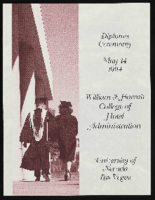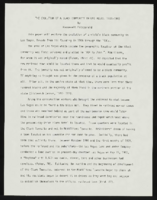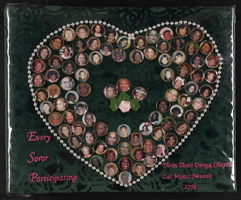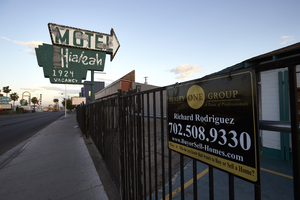Search the Special Collections and Archives Portal
Search Results

Transcript of interview with Pauleen Foutz by Don Scott Kaye, February 25, 1980
Date
Archival Collection
Description
Text

Lauren M. Brown oral history interview: transcript
Date
Archival Collection
Description
Oral history interview with Lauren M. Brown conducted by Claytee D. White on February 21, 2018 for the Remembering 1 October Oral History Project. In this interview, Lauren M. Brown discusses her history with Las Vegas, Nevada, starting from when she moved to the city in 1997. She describes her experience as one of the many who stood in line to donate blood on October 2, 2017, the day after the 2017 Las Vegas mass shooting. Brown talks about what stood out on that day, including the overwhelming amount of people waiting to donate blood and the people who brought drinks and pastries for those waiting. She speaks about how that day showed her the heart of Las Vegas and changed her perspective of the city. Brown also discusses her correspondence with the Healing Garden to give ideas for the design of a permanent memorial for the tragedy.
Text

University of Nevada, Las Vegas (UNLV) William F. Harrah College of Hotel Administration Diploma Ceremony program
Date
Archival Collection
Description
Commencement program from University of Nevada, Las Vegas Commencement Programs and Graduation Lists (UA-00115).
Text

William O'Neill McCurdy Sr. oral history interview: transcript
Date
Archival Collection
Description
Oral history interview with William O'Neill McCurdy by Claytee D. White on January 26, 2022 for the African Americans in Las Vegas: A Collaborative Oral History Project. In this interview, McCurdy describes his childhood growing up in Las Vegas, Nevada, graduating from Valley High School, and attending Western Nevada College in Carson City, Nevada. He worked for many years for the Parks and Recreation department, and has served on numerous boards including the Citizens' Advisory for Regional Transportation (RTC), Habitat for Humanity Board of Director, Mineral County Economic Advisory Committee, City of Las Vegas Community Block Grant Advisory Board, and Southern Nevada Regional Housing Authority Commission. Currently, McCurdy owns McCurdy & McCurdy Media Group, a political consulting and advertising firm which has assisted numerous political candidates in fulfilling their dreams of helping to govern Las Vegas, Clark County, the State of Nevada, and even in the United States Congress.
Text

"The Evolution of a Black Community in Las Vegas: 1905-1940": manuscript draft by Roosevelt Fitzgerald
Date
Archival Collection
Description
From the Roosevelt Fitzgerald Professional Papers (MS-01082) -- Unpublished manuscripts file.
Text

Alpha Kappa Alpha Sorority, Theta Theta Omega Chapter scrapbook: "Every soror participating"
Date
Archival Collection
Description
From the Alpha Kappa Alpha Sorority, Incorporated, Theta Theta Omega Chapter Records (MS-01014).
Mixed Content

Photographs of Hialeah Motel sign, Las Vegas (Nev.), April 18, 2017
Date
Archival Collection
Description
Site address: 1924 Fremont St
Sign owner: La Jolla Development Group, LLC
Sign details: The current building was constructed in 1951 (Assessor). One source states that Tinkler's Motel may have been open on the site in the 1940's (VintageVegas.com, n.d.). A vintage postcard circa late 1940's-early 1950's advertises "Tinkler's Motel Hialeah", although the sign shown in the photograph states" Tinkler's Motel" (CardCow.com, n.d.). A vintage postcard circa 1950's-early 1960's shows the current name,"Hialeah Motel" (Las Vegas motels then and now, n.d.).
Sign condition: Condition is 3, fair. The cabinets are intact with no major rust damage. On the east side of the sign, the paint is flaking moderately on the upper arrow cabinet. On the west side, the paint is flaking severely on the upper arrow cabinet as well as the lower cabinet. Most of the incandescent light bulbs around the upper cabinet remain. All of the neon tubes are gone from both the lower and upper cabinets.
Sign form: Pole sign
Sign-specific description: The lower cabinet is shaped like three rectangles stacked upward in increasing size. The pole runs through the cabinet, which is cantilevered toward the street. The upper cabinet is shaped like an arrow pointed at the motel. The pole and lower cabinet are painted forest green. On the lower cabinet, hand painted sans serif letters state, "Hialeah 1924 VACANCY". The exterior of the upper arrow-shaped cabinet is painted black. The interior is white. The cabinet is channeled and holes for neon tubing are evident, but no neon remains. Yellow incandescent light bulbs outline the exterior of the cabinet. At the center of the pole on the hotel side is a horizontal pole from which a small sign may have hung previously.
Sign - type of display: Incandescent light bulbs, but the sign also had neon tubing at one time.
Sign - media: Steel
Sign - non-neon treatments: Incandescent light bulbs
Sign environment: This is located on East Fremont and has many other motels surrounding it though many of the neighboring motels are shut down.
Sign - date of installation: Possibly 1940's, likely circa 1950's-1960's
Sign - date of redesign/move: A vintage postcard circa late 1940's-early 1950's (CardCow.com, n.d.) shows a small sign which has either been replaced or modified over time. The sign consists of three cabinets mounted symmetrically on a pole. The lower cabinet is painted white and states, "AIR CONDITIONED" or "AIR CONDITIONER". The large central cabinet is black and states, "MOTEL". The smaller upper cabinet is painted black and advertises, "Tinkler's". A vintage postcard circa 1950's-early 1960's (Las Vegas motels then and now, n.d.). shows the current pole and cantilevered lower cabinet without the upper arrow-shaped cabinet. On the lower hotel side of the sign hangs a small yellow sign. Some or all of the lettering is traced with neon letters. By the late 1980's, the motel arrow had been added (VintageLasVegas.com, 2017). "MOTEL" is spelled out in red neon inside the channel of the arrow. The lower cabinet is painted green. "T.V." is spelled in black sans serif letters outlined in white. "Hialeah" is painted in white sans serif letters traced by clear neon letters. Below Hialeah is illegible clear neon, possibly "AIR CONDITIONING" or "AIR CONDITIONER". At the bottom of the lower cabinet "HAMBURGERS", "HOT DOGS" and "VACANCY" are spelled out in white san serif letters. A photograph taken sometime between the 1980's and 2008 (Jacobson, n.d.) shows the lettering on the lower cabinet simplified to the current design, except "T.V." is still painted to the left of "HIALEAH". Three yellow skeleton neon waves underline "T.V." and two more indistinguishable neon tubes of the same type sit over the "T". Some neon around "HIALEAH"in the lower cabinet and all of the neon around "MOTEL"in the upper arrow-shaped cabinet remain. By 2008, the sign had reached its current design (Las Vegas motels then and now, n.d.).
Sign - thematic influences: Horseracing (the motel name references Hialeah Park Racetrack in Hialeah, Florida; vintage postcard shows grass and racetrack type fencing [Las Vegas motels then and now, n.d.])
Sign - artistic significance: This location maintains the Horse Racing theme with their name. They also showcase 1940's (possibly), 1950's-1960's eras themes with emergence and prominence of the motor courts during those eras.
Survey - research locations: CardCow.com. (n.d.). Tinler's [sic] Motel Hialeah. Retrieved from https://www.cardcow.com/281785/tinlers-motel-hialeah-las-vegas-nevada/ Clark County Assessor, parcel no. 139-35-803-004. Retrieved from http://www.clarkcountynv.gov/assessor/Pages/PropertyRecords.aspx?H=redrock&P=assrrealprop/pcl.aspx Jacobson, J. (n.d.). Hialeah Motel [private image, copyright applies]. Retrieved from http://www.pbase.com/easystreet/image/103828763 Las Vegas motels then and now. (n.d.). 15: Hialeah Motel. Retrieved from http://stefanidrivesvegas.com/2.html VintageLasVegas.com. (n.d.). Downtown Las Vegas hotels & casinos 1931-2000. Retrieved from http://vintagelasvegas.com/downtown VintageLasVegas.com. (2017 February 2). Hialeah Motel. Retrieved from http://vintagelasvegas.com/tagged/Hialeah-Motel
Surveyor: Mitchell Cohen
Survey - date completed: 2017-08-23
Sign keywords: Neon; Incandescent; Steel; Pole sign; Directional
Mixed Content

Transcript of interview with Jarmilla McMillan-Arnold by Claytee D. White, October 7, 2010
Date
Archival Collection
Description
Jarmilla McMillan-Arnold’s father, Dr. James B. McMillan, was the first black dentist in the state of Nevada. Dr. McMillan’s colleagues consisted of Dr. West, the first black medical doctor in the state, and Dr. Ice, the first black surgeon in Nevada. This interview highlights and archives the solid foundation upon which Nevada’s black community was built. Jarmilla recalls early memories of growing up as the daughter of Las Vegas NAACP president Dr. McMillan. She was born in Detroit, Michigan, to a Caucasian and Indian mother who was a professional dancer. Jarmilla’s parents separated when she was very young and as a result she was raised by her paternal grandmother who owned a restaurant in Pontiac, Michigan. Jarmilla describes her grandmother as being well-known and highly regarded in the community where she maintained her business. Jarmilla attended Catholic schools in Detroit, Pontiac, and Las Vegas. Having moved to Las Vegas with her father, Jarmilla’s narrative offers keen insigh
Text

Transcript of interview with Sarah & Joni Fried by Barbara Tabach, March 4, 2016
Date
Archival Collection
Description
The website for Freed’s Bakery happily displays the headline: Baking Sweet Memories Since 1959. Today the third generation of Frieds (correct spelling of the family surname) is hard at work creating incredible wedding cakes, cookies, and delightful desserts for the Las Vegas valley. For this oral history interview, Joni Fried, her daughter Sarah Fried, and nephew Max Jacobson-Fried sit to share stories of working in the family business started by Joni’s parents Milton and Esther Fried. Joni has handed the reins over to the third generation who invest their delicious souls into maintaining this Las Vegas tradition. Their tales range from childhood memories of holidays baking and cleaning to their personal favorite desserts. They also explain the impact on their business as early adapters of computer technologies and social media marketing. In October 2017, Freed’s Bakery landed a TV show, Vegas Cakes, on the Food Network.
Text

Jack Weinstein and Polly Weinstein interview, April 12, 2018: transcript
Date
Archival Collection
Description
Tower of Jewels is one of those iconic Las Vegas businesses that continues to thrive. At the time of this interview, Jack Weinstein is in his nineties and “retired.” With him is his daughter Polly Weinstein, who in addition to being involved in the business management has her own custom designed jewelry line, aptly named The Jeweler’s Daughter. As the youngest of six children born to Jewish Russian immigrants Joseph and Pauline (Polly is named for her grandmother), Jack was raised in a dangerous neighborhood of Detroit, Michigan. His youthful enterprise included collaborating and then splitting up with his brothers in a jewelry business, before eventually moving west to Los Angles in the early 1960s. On his own, Jack became a wholesale salesperson representing lines of watches to other businesses. Included in his list of clients was Al Sanford’s Tower of Jewels in Las Vegas. The two became friends and Al suggested setting up a partnership between Al’s son and Jack in 1964. Eventually
Text
